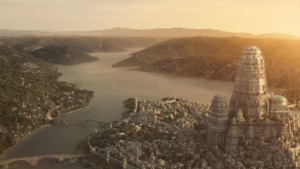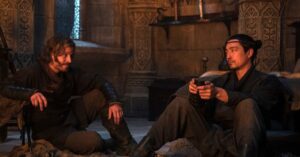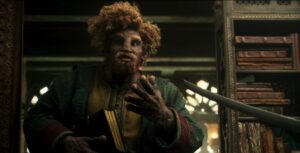SPOILERS FOR THE WHEEL OF TIME EPISODE EIGHT AND THE EYE OF THE WORLD AHEAD!
As if Amazon’s The Wheel Of Time didn’t have enough problems going into its very first season finale, between budget and time constraints, COVID-19 restrictions, and a lead actor leaving during filming, the harsh reality was that this season finale was probably always going to be difficult to get right (and therefore divisive with fans) no matter what…because there’s a precedent in the source material itself.
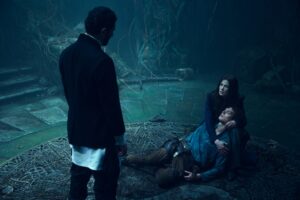
The convoluted and convenient ending of Robert Jordan’s first Wheel Of Time novel, The Eye Of The World, is widely cited as one of the main reasons that fans regard the book as weak in comparison to its sequels; well that, and the fact that tonally and stylistically, it reads more like Tolkien than Jordan, or that it’s heavy on exposition yet the complex magic-system remains vaguely-defined by the end of the book and main characters are just barely fleshed-out. But seriously, a lot happens in the last few chapters that is still confusing even by the end of the series.
Leaving aside the extremely random nature deity who literally appears out of nowhere, Jordan’s version of events involves two of the series’ most inconsequential Forsaken popping up out of the ground to challenge Rand al’Thor (Josha Stradowski) to a magical battle at the Eye of the World. Things get really weird and trippy from there, Rand instantaneously teleports to Fal Dara and singlehandedly defeats an army of Shadowspawn because he can just…do that now, kills “The Dark One”, possibly talks to The Creator (a.k.a. God), then returns to the Eye to find the long-lost Horn of Valere and the banner of the Dragon Reborn.
Some of the questions that first-time readers have upon finishing The Eye Of The World are answered in later books. Some aren’t. The general consensus among fans is that while Robert Jordan had a lot of his story already figured out when he wrote that first book, the rules of his magic-system weren’t locked down at that point. On top of that, he wanted The Eye Of The World to work as a self-contained story in case he never got to publish the sequels, which explains the deceptive triumphant tone of the ending.
It’s unsurprising and understandable that Amazon’s Wheel Of Time adaptation didn’t aim for loyalty to the books in this instance, because frankly it wouldn’t have made much sense if they had. Jordan’s fourteen-volume series came to an end in 2012 with the help of Brandon Sanderson, so the magic-system is now fully-realized and the inconsistencies in The Eye Of The World are outliers anyway. And because Amazon greenlit The Wheel Of Time for a second season months ago, there’s no need for the writers to tack on a misleading happy ending as Jordan did.
But for every problem solved in the adaptation process, a new one arises that is exclusive to this medium – and hopefully to this first season, specifically. Amazon dictates have apparently been a thorn in showrunner Rafe Judkins’ side since early days of production, when the studio shot down his idea for a 2-hour pilot episode. Then COVID-19 happened, and when The Wheel Of Time was allowed to resume filming after a months-long hiatus with new restrictions in place, one of the show’s lead actors, Barney Harris, didn’t return to set, requiring Judkins and his team to rewrite the last two episodes to account for his absence.
Behind the façade of this otherwise mostly enjoyable episode hide patches of frantically-rewritten story and dialogue loosely holding the whole structure together – like puzzle-pieces that when assembled, form a picture of chaos behind-the-scenes. Most egregiously, the writers don’t seem to have finished removing Mat Cauthon (Barney Harris) from this episode, so the silhouette of what was clearly intended to be his subplot remains visible, awkwardly filled by the character of Perrin Aybara (Marcus Rutherford).
Thematically, it makes no sense whatsoever for Perrin to confront the Darkfriend Padan Fain (Johann Meyers), or for their conversation to unfold the way it does, with Padan taunting Perrin about succumbing to the darkness. This entire sequence, which concludes with Padan Fain stealing the Horn of Valere from its secret vault under the throne of Fal Dara (in the books, it’s discovered at the Eye of the World), was very obviously intended to feature Mat – the only character with whom Padan ever interacted, whose potential for darkness was so strong that Padan guided him to the cursed dagger in Shadar Logoth.
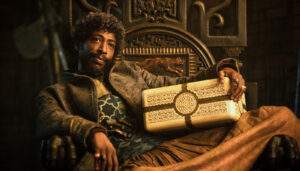
Presumably, in the version of the finale we’ll never get to see, Padan would have encouraged Mat to take the next step towards joining the Dark One, before stabbing him with the cursed dagger and leaving with the Horn of Valere after Mat inevitably fought back. In the version we did get, Padan randomly stabs Loial (Hammed Animashaun) and leaves him for dead, although Rafe Judkins has confirmed that Loial is alive. Either way, it would have set up the events of The Great Hunt and the connection that Mat has to the Horn more effectively than a split-second shot of Mat in Tar Valon while Padan is talking to Perrin.
Perrin actually spends most of the episode talking and running around aimlessly, while a battle rages outside the walls of Fal Dara that we barely get to see because apparently Perrin adopted the pacifistic Way of the Leaf at some point (never shown onscreen) and now refuses to fight. Don’t get me wrong, I’d be fully onboard with that character development if Perrin did anything cool or compelling instead, but the weak action scenes scattered throughout this episode really could have benefited from a character with the instincts, reflexes, and unique abilities of a wolf.
There’s a lot of buildup to the Battle of Tarwin’s Gap, and the characters even delude themselves into thinking that the Last Battle, Tarmon Gai’don, is upon them, but all the time spent developing Fal Dara’s warlords Agelmar (Thomas Chaanhing) and Amalisa (Sandra Yi Sencindiver) goes to waste on a “battle” that consists of one embarrassingly puny cavalry charge and a single barrage of arrows. Agelmar, who survives The Eye Of The World, is impaled within the first five minutes by a Trolloc, at which point the fortress at Tarwin’s Gap falls (they call it a fortress, I call it a glorified palisade).
Throughout this…skirmish, the camera refuses to linger very long on the close-quarters action, for good reason. COVID-19 restrictions prevented The Wheel Of Time from filling out the armies on either side with human extras, and even the actors who portrayed the Trollocs and Myrddraal in the first few episodes using extraordinary practical effects and prosthetics have been replaced by a patchy CGI swarm that pours into the flat wasteland before the walls of Fal Dara and is conveniently obliterated by Amalisa, Nynaeve al’Meara (Zoë Robins), and Egwene al’Vere (Madeleine Madden) before they come into focus.
To the surprise of no one (including the VFX department, I’m certain), this unfinished army of Shadowspawn doesn’t look all that great even from a distance, in total darkness. But it still required money to build from scratch, and that’s money that’s clearly been siphoned away from the special effects in other areas, including the incoherent thunderstorm of saidar summoned by Amalisa (using Nynaeve and Egwene’s power) that eventually reduces the Shadowspawn to cinders in what is already one of the finale’s most confusing – and controversial – original scenes.
Let me try to break it down for you. During the final battle, as the Shadowspawn approach, Amalisa orders Nynaeve, Egwene, and a handful of weaker channelers to “link” with her, something we saw the Aes Sedai do in episode four to collectively gentle Logain. But as we learned from Moiraine (Rosamund Pike) in episode seven, Amalisa herself is weak, and clearly lacks the necessary Aes Sedai training to pull off this difficult maneuver. Instead of equally distributing the One Power amongst her teammates, Amalisa absorbs it all into herself and goes nuclear, quickly burning out.
The same fate befalls everyone tied to her by the link, as one by one the weaker channelers are ripped apart from within by the One Power, which leaves blackened craters where their facial features used to be (a delightfully grisly visual). But eventually Nynaeve wrests control of the One Power from the disintegrating Amalisa to protect Egwene, and burns out. For a moment it’s even implied that she’s dead…but then Egwene heals her anyway. And that, to me, is the only part of this sequence that warrants criticism, because honestly everything else is appropriately terrifying and exhilarating.
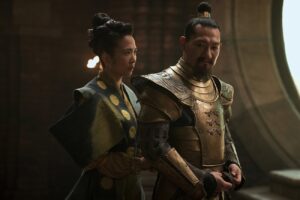
But seriously, another fake-out death? Really? This is a trope that is extremely difficult to write well even once in a story, and The Wheel Of Time has now “killed” Nynaeve twice. The first time around, when Nynaeve was abducted by a Trolloc, the manner in which she cheated death actually told us a great deal about her character – and as we learned from Padan Fain, she was never really in danger of being killed because the Trollocs planned to bring her to the Dark One. We don’t learn anything new about Nynaeve when she “sacrifices” herself to save Egwene; only that she’s apparently invulnerable.
Across all fourteen volumes in Robert Jordan’s Wheel Of Time saga, no burned out channeler ever has their ability to channel restored – and the fact that in this instance it’s Egwene (canonically one of the weakest healers) who miraculously saves Nynaeve makes this scene all the more amusingly inaccurate to the books. That’s not necessarily a problem for the time being, because The Wheel Of Time hasn’t established many of the laws of channeling yet, but down the line one would hope that we get an explanation for what Egwene did in this moment.
My fear is that the explanation, if we ever get one at all, will be in the form of some dismissive offhand comment to the effect of “she’s ta’veren; deal with it”. My hope is that The Wheel Of Time plans to actually explore the intricate mechanics of channeling in its second season, partially through Nynaeve and Egwene as they try to piece together what went wrong with their linking-circle and how they can learn from their mistakes (by training with the Aes Sedai in Tar Valon), and partially through Moiraine, who was unexpectedly humbled by “The Dark One” (Fares Fares) at the Eye of the World, losing her own ability to channel.
Fans are divided over what exactly happened to Moiraine. She can’t channel, but can still feel the One Power at her fingertips, indicating that “The Dark One” either “shielded” her or “stilled” her. The former is more likely, because the magic net that “The Dark One” cast over Moiraine was very similar to the shield that the Aes Sedai used to bind Logain in episode four, and nothing like the probes they used to rip the One Power out of his chest when they “gentled” him. Gentling and stilling both refer to the act of removing a person’s ability to channel entirely, and the consequences are believed to be permanent.
Shields, thankfully, can be undone – although the process requires patience, persistence, and in many cases assistance from another channeler, especially if the “weaves” used to create the shield were extremely complex or archaic (and “The Dark One” is many thousands of years old, so we can safely assume he learned his weaves sometime during the fabled Age of Legends). That’s good news for Moiraine, but keep in mind that women in Jordan’s world can’t see when men channel (and vice versa), so Moiraine doesn’t know what “The Dark One” did to her, or how deep the damage goes.
It’s reasonable to assume that Moiraine will have to search for help from other Aes Sedai in season two, seeing as Nynaeve’s mental block is now firmly in place, preventing her from channeling, even to heal, except when she’s angry, and Egwene, well…actually, this would be a lot simpler if Egwene were still really bad at healing, but…yeah, I don’t know how they’re going to explain why Egwene can’t just undo Moiraine’s shield the same way she undid Nynaeve’s burning out. This is why we need that explanation for what she even did to Nynaeve in the first place, and fast!

On top of all that, the Seanchan colonists make their first live-action appearance at the very end of the episode, leaving audiences with a frightening mental image of all the sadistic, creative ways in which the One Power can be abused. Women with the ability to channel, including captured and enslaved Aes Sedai, make up the lowest class in Seanchan society, where their movements can be controlled by non-channelers through the use of special collars (which in the show are coupled with golden gags). The Seanchan are seen using them to conjure a tidal wave in advance of their arrival on the western shores near Falme.
There’s not much I can actually say about the Seanchan without skirting around Wheel Of Time spoilers. I mean, I could just rant for hours about the production design and costume design failures that continue to plague this show, including the tacky skull helmets that I naively want to hope were stolen from the set of a 1990’s B-movie because the thought of any professional costume designer approving those in 2021 is frankly embarrassing, and the fact that every flat surface on the Seanchan ships is inexplicably covered in giant spikes, but nobody wants to hear me rant (unless you do, in which case I will happily oblige).
Besides, I actually have nice things to say about the production design, too. Not as many nice things as I would like to be able to say, but enough to fill out this paragraph at least, because for one brief flashback to the Age of Legends (hopefully the first of many), the eclectic sets, props, costumes, and production values are in perfect harmony with each other, united by a sleek and streamlined science-fantasy aesthetic. The actors even speak in the Old Tongue invented by Robert Jordan to immersive effect.
The scene gives us insight into the events that preceded the Breaking of the World three-thousand years before Rand’s time, when Lews Therin Telamon (Alexander Karim), in his arrogance, impatience, and desire to protect his loved ones, foolishly chose to try seal the Dark One away forever, ignoring warnings from the Tamyrlin Seat that he would expose the male half of the One Power to the Dark One’s corrosive influence in so doing. Rand al’Thor, Lews Therin’s reincarnation in the Third Age, similarly fails to see the bigger picture, which is why his victory at the Eye of the World is…incomplete.
And yet, Rand’s confrontation with “The Dark One” at the Eye is an unequivocal improvement on the world-hopping swordfight that concluded the first book in Jordan’s series. Usually, adaptations look for opportunities to expand on action and visual spectacle – but this is the rare instance where the opposite is true, and Rand finds himself battling not a physical opponent, but his own worst impulses. “The Dark One” tempts him with a tantalizing vision of the simple life he wanted with Egwene back in the Two Rivers, telling him that with his newfound power he can force the Wheel of Time to weave this fiction into a reality.
And he still wants it, desperately. The scene wouldn’t be effective if he didn’t. But his epiphany, which ultimately gives him the strength to turn on “The Dark One” and blast him out of existence with a blinding sunbeam of power, is that he wanted this future with Egwene because he loves her deeply, deeply enough to know that she doesn’t want it. She has her own hopes and dreams of becoming the village Wisdom someday, or even an Aes Sedai, dreams he may never understand but which he will always respect and accept because he loves her. And I just think that’s beautiful.
Of course, by giving up his one chance at the life he always wanted, Rand simultaneously shoulders the responsibilities and burdens of the lonely life he’s got. And Rand being Rand, instead of seeking guidance, he chooses to go into self-imposed exile after defeating “The Dark One”, instructing Moiraine not to come looking for him or even to tell his friends that he’s alive – because the way he sees it, he won’t be for much longer. All that’s left for him now is the slow descent into insanity that awaits all male channelers.
At least, that’s what he thinks. Without getting into spoilers for the books, all I’ll say is what’s already implied by Moiraine in the episode itself; that the events at the Eye of the World warrant close examination, because what Rand thought happened and what actually happened are not necessarily the same thing. This may not have been immediately obvious to readers back in 1990, but Robert Jordan’s series now has fourteen books, a prequel novel, and several spin-off stories, so there’s not much point in hiding that this is just the beginning of Rand’s story.
Well, let me rephrase that; it is not the beginning, for there are neither beginnings nor endings to the turning of the Wheel of Time.
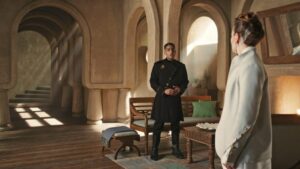
But it is a beginning – perhaps even a new beginning for Amazon’s series, which will enter its second season free of the heavy baggage that season one struggled to carry. A recast Mat’s return will obviously restore some cohesion to the story, but on top of that the budget has been increased, and The Wheel Of Time is now a proven success on streaming, which will appease the skeptical Amazon executives. The writing choices made throughout season one allow season two to hit the ground running and almost immediately branch out in exciting new directions.
If this season finale was messy (and don’t get me wrong, it absolutely was), it’s only so that season two doesn’t have to be.
Episode Rating: 6/10







